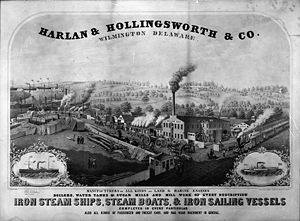Harlan and Hollingsworth Co.
 |
|
| Private | |
| Predecessor | None |
| Successor | Bethlehem Steel |
| Founded | 1837 (as Betts, Pusey and Harlan) |
| Founder | Mahlon Betts, Samuel Pusey, Samuel Harlan |
| Defunct | 1904 |
| Headquarters | Wilmington, Delaware, USA |
| Products | Iron ships and ship-related machinery, wooden railroad cars, sugar refining equipment |
| Revenue | $580,000 (1860) |
Harlan & Hollingsworth was a Wilmington, Delaware, firm that constructed ships and railroad cars during the 19th century and into the 20th century.
Mahlon Betts, a carpenter, arrived in Wilmington in 1812. After helping construct many prominent buildings in the city, Betts branched out into foundry work in 1821. In 1836, Betts partnered with Samuel Pusey (a machinist) and began manufacturing railcars at a plant on West and Water Streets in Wilmington. The next year, cabinetmaker Samuel Harlan joined the firm, then known as Betts, Pusey & Harlan. By 1839, the company claimed to have manufactured 39 passenger and 28 freight cars over the previous two years. The next year, they hired Jacob F. Sharp, a former house carpenter, to build railroad cars. He would rise to become foreman at the plant, and eventually co-founded the rival firm of Jackson and Sharp.
In 1841, Elijah Hollingsworth, brother-in-law of Harlan, bought out Pusey, and the firm became known as Betts, Harlan & Hollingsworth. Pusey later formed competing Pusey and Jones. In 1849 Mahlon Betts withdrew from the firm, which became simply Harlan & Hollingsworth; J. Taylor Gause was admitted as a partner in 1858, and the company became known as Harlan, Hollingsworth & Co..
Harlan & Hollingsworth's experience with railcars and other ironwork led them to become early experimenters in iron shipbuilding. In 1842 the company hired Alexander Kelly to supervise all the millwright work. In 1843, under the encouragement of Samual Harlan, the company started engaging in marine engine building and repair. Their first ship-related project was repairing the cylinder and other machine parts of the steamboat Sun. This small step was the beginning of what would become one of the first iron shipyards in the United States.
Harlan & Hollingsworth's expanded slowly but steadily into iron shipbuilding. Only nine ships were built between 1841 and 1851, with most of the company time taken with railroad car building and general repair work. In 1843 the company leased a launching berth on the banks of the Christiana River. The facilities at this property were limited, so all the work forming iron plates, bars, and fasteners was done at their main shop on Front and West Streets. The launch slipway was 200 feet long and could only accommodate vessels of 600 tons maximum, but this was deemed adequate for the needs of the time.
...
Wikipedia
